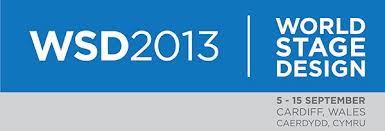Through a series of workshops and talks, a group of amateur critics, professionals within the media, and other interested parties discussed and dissected what criticism is today, and where it could go in the future. As a part this, Tom Beardshaw of NativeHQ ran a workshop re-considering the form of the critical review in the internet age, and we were tasked with approaching the World Stage Design at the Royal Welsh College of Music and Drama in a different manner to the usual written review.
The World Stage Design is an international celebration of design, exhibiting work in theatre, opera and dance, as well as bringing together theatre practitioners and artists through a whole range of workshops and performances throughout the festival. The work displayed is incredible and the range of designs makes it a valuable experience for everyone. Find out more about the festival here.
To briefly summarise Tom Beardshaw’s words, media as a whole has been transformed by the Internet. Publication is now primarily based on the Internet, with print having become an aspect of a larger whole, where it used to be the dominating force. However, in the process of this repositioning the critical review, and much else of the content in publication, has simply been transplanted from the printed tabloid form. We are only beginning to grasp the possibilities that the Internet offers, one of which is a much more fluid and dynamic view of form, as well as the interaction between the producers and the consumers of content, in this instance critics, artists and readers.
For the review of the festival, I worked alongside Chelsea Gillard and Elin Williams, and we decided to use Vine to produce our content for the festival, collecting our responses on Pinterest. This was driven by the visual basis of the event as well as a desire to experiment with the compact narratives Vine videos can produce. The results can be seen on the Pinterest board World Stage Design.
As the nature of our publication shows, there is a limited access to viewing Vine videos at the moment. The end result is more a Pinterest board with extra links, and it would have probably worked out better had we solely used photos.
Here is what is good about Vines: they are quick, you are able to produce animations out of real life, they have great creative potential, you can make stories, they don’t require a great deal of expertise. Here is what is bad: they are so quick, the image quality isn’t ideal, and, as we discovered, they kind of need to work within a narrative.
Perhaps the case would have been different if we were able to collect the vines in abother way, but having them on the Pinterest page does make me wish I had just taken photos. But what the experience did show me that I really love Pinterest being part of a review, as it is a quick way to extend to the design aspects you would normally miss in most written reviews. It also made me realise the importance of being able to utilise these new formats that the Internet offers, to be one step ahead and grasp the potential that is out there. Even for the World Stage Design, an intrinsically visual based event, there are few pins and boards at the moment.
Ultimately, I have a pull between the desire for broadness and the art of words. We talked a lot about how lucky we are to be in this age where there is so much to exploit and create, whilst ourselves being connected to technology; we are used to the speed with which things develop, and adapt to using new apps and sites with ease. But, for myself, and I think Chelsea and Elin as well, it almost feels like we are at the edge between the two. We are old enough to remember sitting by the fire with our favourite bedtime stories and nothing else, we remember the AOL dial-up that connected by the phone line and took an hour to receive an e-mail (for nostalgia’s sake here is that wonderful dial-up sound), we remember walkmans tapes (just about), we remember when hotmail was the only email. But at the same time, we are not quite young enough to have totally embraced technology: I still don’t use instangram, I have grown tired of injecting hours on facebook staring at the fun my fellow graduates are having on their holidays, I have yet to be snap chatted. There are too many apps for me to care.
I truly believe that there will always be power in the printed word and for people who have made an art of language. But I have also seen that the life of the professional tabloid critic is increasingly a thing of the past, and I’m not really suited to that format anyway. For me reviewing is definitely about opening a relationship between artists and myself: I only write reviews to get tickets to a show, otherwise I would never be able to afford to go to the theatre. I’d like to think that I am level headed enough to be able to open a dialogue, and I hope that it brings a level of sensitivity to writing for work I don’t agree with.
So, I welcome comment boxes and Pinterest boards and tweets and GIFs and any other nonsense that the Internet will bring. So long as, in the end, it works towards making better art, and building a better creative community.

